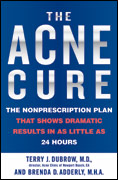The Acne Cure, by Terry J. Dubrow and Brenda J. Adderly
reviewed 2005-01-25 by Elishalom Yechiel, Ph.D.

The Acne Cure (Terry J. Dubrow and Brenda J. Adderly, Rodale, 2003) touches multiple issues: the basic structure of skin; skin aging and possible causes; skin maintenance. The goal of addressing these issues is to introduce to the reader the “four step breakout and cure” acne theory.
The book is written in simple, clear and flowing language that can be understood by lay people. The authors are well acquainted with the material they present and Dr. Dubrow is quite experienced in the field of acne. While avoiding technical rhetoric, being on the simple side, and not intended to be comprehensive, the writing is respectful to the reader and does not oversimplify the problem of acne.
The proposed acne cure itself is presented in Chapter 4; all the other chapters provide good supplemental and background material that helps present the authors’ case for the causes and cures of acne breakouts. The authors’ main point is that acne is highly curable and they criticize the industry for not being clear about that and causing unnecessary anguish among acne sufferers. Their other point is that, for most cases, acne can be cured by very simple remedies available without prescription, and that antibiotics and Accutane™ can and should be avoided for 95% of all acne cases.
Their four-step acne breakout explanation is matched with a four-step acne cure. This acne cure does not suggest a new idea or new actives against acne, but suggests a step-by-step application of well-known actives including a beta hydroxy (salicylic acid) followed by a alpha hydroxy (glycolic acid) followed by a bacteriocide (benzoyl peroxide). Their point is that, applied simultaneously, these actives will not be as effective as when applied in the proper sequence in a step-by-step program.
Ironically, the most important part of the cure is the ice-pack recommended to reduce inflammation and improve absorption of the benzoyl peroxide. It is indeed a simple remedy and not something that sounds like ground-breaking medicine. However, the ice-pack is introduced because the question of topical penetration must be addressed, and that is a critical issue in modern topical formulations. Inflamed acne has built-in pressure, aggressively pushing materials out; the likelihood of actives penetrating through that pressure and into the affected area is even smaller than for relaxed skin (for which penetration is already a difficult and complex issue).
The ice-pack is indeed just the tip of the iceberg related to the skin permeability problem; finding ways to help existing actives get better access to a problem area is indeed often the best way to make progress toward a solution. Topical trans-dermal and intra-dermal vehicles that can facilitate penetration of actives into skin are now being sought and developed and may be the front runners in new discoveries in bio-technology.
The book is recommended for lay people and professionals alike; everyone can learn a thing or two from this book.